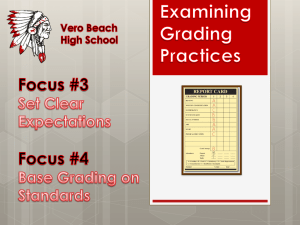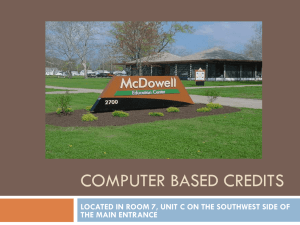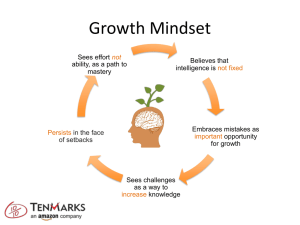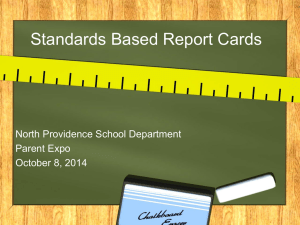OAT1 D2 sf11 KE
advertisement
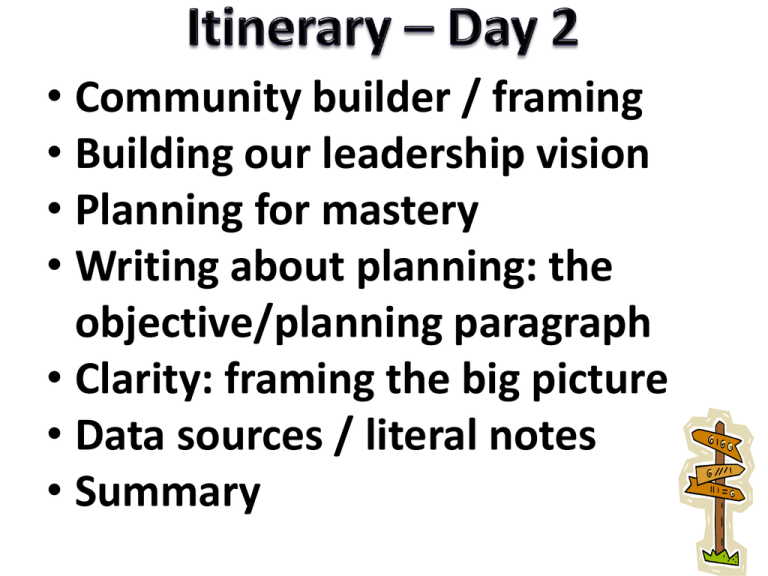
• Community builder / framing • Building our leadership vision • Planning for mastery • Writing about planning: the objective/planning paragraph • Clarity: framing the big picture • Data sources / literal notes • Summary ▲ ▲ page xiii ▲ ▲ Overarching Objectives Curriculum Design Planning ▲ Objectives Learning Experiences Assessment Personal Relationship Building Class Climate ▲ Expectations Clarity Space Attention Principles of Learning Time Momentum Models of Teaching Routines ▲ ▲ Discipline FOUNDATION OF ESSENTIAL BELIEFS ▲ Objectives Personal relationships Climate Expectations Principles of learning Clarity Attention Momentum Beliefs Welcome! • Sign in. • Wear your name tag. • Pick the top card and sit at that numbered table. (A=1) • What practices or concepts have become clearer to you as a result of today’s class? • How will this knowledge support your growth as an instructional leader? Practices or concepts that have become clearer to you and that will support your growth on the first steps on the journey : The knowledge base on teaching / triangle (10) Scripting – what it is, why we do it (8) The components of a report AKA “the recipe” (5) CEIJ (5) The six standards of the PGS (3) Pluses + Sharing with partners, in groups, at tables (9) + Pacing/momentum (3) + Exemplars (4) + Class climate (4) + Presenters + Deltas Δ Provide more processing time (2) Δ Go faster / go slower • Tell your partner your phone number. They will call you. • Share the name of your ring tone and why you chose it. • Change roles. • Be prepared to report on your partner’s choice. Framing our learning By the end of the day you will be able to: • Explain how supervision and evaluation support the purposes of the Professional Growth System. • Explain different levels of thinking about lesson planning and their implications for student learning. • Evaluate objectives based on the criteria for a mastery objective. • Analyze evidence to determine if a teacher is planning and instructing for mastery. • Write an objective paragraph in a post-observation conference report. • Identify components of a teacher’s repertoire for framing learning and explain their importance to students. • Explain the importance of literal note-taking and determine whether notes are literal or descriptive. • Community builder / framing • Building our leadership vision • Planning for mastery • Writing about planning: the objective/planning paragraph • Clarity: framing the big picture • Data sources / literal notes • Summary OAT I DATA ABOUT TEACHING & LEARNING KNOWLEDGE ABOUT TEACHING Instructional Leadership EFFECTIVE COMMUNICATION HIGH EXPECTATIONS FOR ADULTS RBT The Knowledge Base on Teaching KEY CONCEPTS • Areas of Performance • Repertoire • Matching Overarching Objectives Curriculum Design Planning CURRICULUM PLANNING Objectives Assessment Personal Relationship Building Learning Experiences Class Climate MOTIVATION Expectations Clarity Space Principles of Learning Time Models of Teaching INSTRUCTIONAL STRATEGIES Routines MANAGEMENT Attention Momentum Discipline FOUNDATION OF ESSENTIAL BELIEFS + CONFIDENCE ABILITY ACHIEVEMENT + EFFECTIVE EFFORT Hard Work Strategies Source: Adapted from Efficacy Institute, Lexington, MA. TST p. 270 Smart is not something you just are; smart is something you can get. Jeff Howard The Efficacy Institute Which of the seven beliefs are alive, well, and in evidence in your workplace? What effect do you see them having on student learning? Which are least evident? Why? How does their absence influence student learning? Discuss the implications of your responses for your leadership role. TST Chapter 2 OAT I DATA ABOUT TEACHING & LEARNING KNOWLEDGE ABOUT TEACHING Instructional Leadership EFFECTIVE COMMUNICATION HIGH EXPECTATIONS FOR ADULTS RBT By the end of this portion of the day, you will be able to explain how supervision and evaluation support the purposes of the Professional Growth System. Objective Review: The Six Standards Stand. Find your EXPECTATIONS partner. Recite the six standards to him or her. Share the strategy you used to be able to remember them. MCPS Teacher Standards I. II. III. IV. V. VI. Teachers are committed to students and their learning. Teachers know the subjects they teach and how to teach those subjects to students. Teachers are responsible for establishing and managing student learning in a positive environment. Teachers continually assess student progress, analyze the results, and adapt instruction to improve student achievement. Teachers are committed to continuous improvement and professional development. Teachers exhibit a high degree of professionalism. Discuss which of the major purposes of supervision and evaluation have been most and least successfully addressed in MCPS. How do your strategies for working with your staff match these descriptors? Purposes of Supervision and Evaluation NB p. 27 Where is the balance of these three aspects of leadership in your current work? What goals might you set for yourself in relationship to these three aspects? Recipe for a PostObservation Conference Report 1. Context paragraph 2. Objective/mastery planning paragraph 3. C E I J paragraphs • Claim – area of performance • Evidence • Interpretation of impact on students (thus, as a result, therefore) • Judgment included or implied 4. Post-observation conference summary (including goal-setting) 5. Summary Teacher: Observer: School: Subject / Grade: Observation Date: Observation Time: Conference Date: Provides information about… Teacher Students Course or unit of study Special factors Announced or unannounced Feedback: Information on the ways in which a product or performance meets or does not meet established criteria for success. Peer Feedback: The Context Paragraph Recipe for a PostObservation Conference Report 1. Context paragraph 2. Objective/mastery planning paragraph 3. C E I J paragraphs • Claim – area of performance • Evidence • Interpretation of impact on students (thus, as a result, therefore) • Judgment included or implied 4. Post-observation conference summary (including goal-setting) 5. Summary Compare your labeling of the CEIJ in paragraphs three through five in the Sarah Smith report. Come to consensus, if possible. Sarah Smith CEIJ Paragraph 1 Mrs. Smith effectively presented information through explanatory devices. • She created a graphic organizer on the overhead projector to guide the students through defining run-off. • She translated the words dissolved and suspended into simpler language by way of a class discussion (“Spring-time…fertilizer on grass to make it greener…that salt fertilizer will mix with water and dissolve…we need to talk about what that word suspended means…okay we’re talking about debris..anything that doesn’t get dissolved…”). • She also presented the students with environmental pictures (“To get started I have pictures with pretend news articles about the Chesapeake Bay…”). As a result, students with a variety of learning styles were focused and engaged. Sarah Smith CEIJ Paragraph 2 Mrs. Smith used several instructional strategies to help the students make cognitive connections. She used questioning as a way to prompt a resemblance to the students’ experiences (“What’s usually included with pictures?...If something gets dissolved, what does that mean?”). She used a personal experience to help the students related the content to their own lives (“I took my cup of coffee and put sugar in it. It got dissolved in the coffee...” ). She asked the students to compare and contrast in order to make a connection to today’s learning (“Think about the pictures we looked at yesterday…”). Thus, students’ prior learning was utilized and connected with the new information given during this lesson. Sarah Smith CEIJ Paragraph 3 Mrs. Smith has built a classroom climate in which students feel safe to take risks. • She made several comments throughout the lesson to promote risk taking (“..could be…you could make that up…you don’t have to be perfect…”). • She stated, “…as long as someone at your table has something to share we’re good.” • After the students were told to write captions for given pictures, a student asked, “What’s a caption?” Mrs. Smith did not chastise the student for not knowing or remembering the meaning of the word caption, but answered her calmly and respectfully. Another student asked a question and Mrs. Smith replied quietly. Therefore, students could safely communicate their level of understanding and signal their need to move on or request help. CLAIM statement that a teacher performs a certain teaching skill EVIDENCE a quote or literal description of something said or done; at least three pieces of evidence are needed to constitute sufficient documentation to support a claim IMPACT statement of what the behavior accomplished; the effect on students; “the students” are the subject JUDGMENT adjective, adverb, sentence, phrase that lets the reader know what the writer thought of the teacher’s behavior; most often found IN the claim • Is a statement of what was accomplished by the behavior just described in the claims and evidence. • Establishes what was significant about the move in terms of students. • Has “the students” as its subject. Effective impact statements: Show a logical cause-effect relationship with the claim. Match the evidence. Have the students as their subject. May include judgment by stating the quality (positive or negative) of the impact on students and their learning. As a result, students remained unclear as to the desired standard of work. Thus, students were able to reiterate the standards for their projects. Review NB pp. 45-46. Evaluate each of the sample impact statements. Does it clearly communicate the effect of teacher behavior on students? Does it use the students as the subject? Discuss with your partner. Let’s take a break! By the end of this part of the day, you will be able to: • Explain different levels of thinking about lesson planning and their implications for student learning. • Evaluate objectives based on the criteria for a mastery objective. • Analyze evidence to determine if a teacher is planning and instructing for mastery. Objectives OAT I DATA ABOUT TEACHING & LEARNING KNOWLEDGE ABOUT TEACHING Instructional Leadership EFFECTIVE COMMUNICATION HIGH EXPECTATIONS FOR ADULTS RBT The Knowledge Base on Teaching KEY CONCEPTS • Areas of Performance • Repertoire • Matching Overarching Objectives Curriculum Design Planning CURRICULUM PLANNING Objectives Assessment Personal Relationship Building Learning Experiences Class Climate MOTIVATION Expectations Clarity Space Principles of Learning Time Models of Teaching INSTRUCTIONAL STRATEGIES Routines MANAGEMENT Attention Momentum Discipline FOUNDATION OF ESSENTIAL BELIEFS Activator What are the characteristics of standards-based instruction? 45 “To begin with the end in mind means to start with a clear understanding of your destination. It means to know where you’re going so that you better understand where you are now, so that the steps you take are always in the right direction.” Steven Covey The Seven Habits of Highly Effective People Use the text marking strategy to read the handout. Got it. ! This is important. (I could explain it to someone else.) (This is a key point.) ? What??? (I don’t understand it yet.) THINKING SKILLS OBJECTIVES What thinking skills do I want students to be able to use? MASTERY OBJECTIVES What do I want students to know or be able to do when the lesson is over? How will I know if they know it or can do it? INVOLVEMENT How can I get students really engaged? ACTIVITIES What activities could students do to gain understanding or to develop these skills? COVERAGE Thinking Behind What knowledge, skill,OBJECTIVES or concept am I teaching? Data From Pre-Assessment: Objectives and Criteria for Success Number assessed: 22 Met standard Objectives 32% 68% 10% 90% Criteria for Success NY (not yet) Yes NY Yes NY 49 The language of a mastery objective… • is specific in terms of curricular knowledge (declarative or procedural) • names an active performance (observable behavior) that demonstrates mastery TST p. 377 Source: Jon Saphier, Mary Ann Haley-Speca, and Robert Gower. 2008. The Skillful Teacher, 6th ed. Acton, MA: Research for Better Teaching, p. 377. 50 Mastery objectives do not use mental action words that do not inform students about what they will have to do to demonstrate mastery, such as… TST p. 377 Source: Jon Saphier, Mary Ann Haley-Speca, and Robert Gower. 2008. The Skillful Teacher, 6th ed. Acton, MA: Research for Better Teaching, p. 377. A 51 Mastery Objective: By the end of class, you will be able to identify an infectious disease, the pathogen that causes it, and how the pathogen is spread. Activities: 1. Research and take notes about infectious diseases. 2. Work as a group to ask and answer questions about infectious diseases. 3. Complete today’s Learning Log. Students will be able to draw and explain the life cycle of a butterfly using a cycle graphic organizer. (ES science) You will be able to identify the physical traits of a character and support each with at least two pieces of evidence from the text. (MS English) We will be able to make an accurate scale drawing of a room or apartment given actual dimensions. (HS math) Parents will be able to describe ways that they can support their children with homework. (Parent meeting) Students will be able to identify strategies for resolving conflict and apply them to a given scenario. (Counseling session) Staff will be able to describe three interactive strategies and how they can apply them in class. (Department meeting) Work with a job-alike partner, if possible. Select at least two objectives. Discuss how you might coach a teacher to revise the objective for a focus on mastery. What questions would you ask? 1. Put your name on an index card. 2. Write at least two original mastery objectives. 3. Put the index card into the table folder. OAT I DATA ABOUT TEACHING & LEARNING KNOWLEDGE ABOUT TEACHING Instructional Leadership EFFECTIVE COMMUNICATION HIGH EXPECTATIONS FOR ADULTS RBT By the end of this portion of the day, you will be able to write an objective paragraph in a post-observation conference report. Objective Recipe for a PostObservation Conference Report 1. Context paragraph 2. Objective/mastery planning paragraph 3. C E I J paragraphs • Claim – area of performance • Evidence • Interpretation of impact on students (thus, as a result, therefore) • Judgment included or implied 4. Post-observation conference summary (including goal-setting) 5. Summary What might a student experience in a lesson planned for mastery? What do we want students to know and be able to do? How will they get there? What task will tell us they can do it? What should successful performance look like? Mastery objective (target) Activities (learning experiences) Assessment (product or performance) Criteria for success (characteristics of exemplary work; highest point on a rubric) The purposes of the objective paragraph are to: • capture the teacher’s thinking, planning, and delivery of instruction; • record the activities that were planned to lead students to the mastery objective; and • explicitly present the data on student achievement of the mastery objective. The Objective / Planning Paragraph The objective paragraph must answer… • • • • Was the lesson planned for mastery or not? What was the objective? How was it communicated? What activities did the teacher do to lead students to mastery of the objective? • What are the assessment data on student mastery or progress toward mastery of the objective? • A lesson with a clear, communicated mastery objective is not always taught for mastery. • A lesson without a clearly or clearly communicated mastery objective can be taught for mastery. • the stated objective; • the lived/delivered lesson; and • the worthiness of the objective and lesson. Giving Objective-Focused Feedback: The Stoplight RED: The objective does not reflect mastery thinking or planning (based on coverage, activity, or involvement thinking). The delivery of instruction does not match or support the intended objective. YELLOW- The objective MAY reflect mastery thinking or planning. The delivery of instruction does not match or support the intended objective. GREEN- The objective reflects mastery thinking or planning. The delivery of instruction and teacher actions fully match and support the intended mastery objective. Leadership Connections How will you, as an instructional leader, ensure that teachers plan lessons focused on student mastery? OAT I DATA ABOUT TEACHING & LEARNING KNOWLEDGE ABOUT TEACHING Instructional Leadership EFFECTIVE COMMUNICATION HIGH EXPECTATIONS FOR ADULTS RBT By the end of this part of the day, you will be able to identify components of a teacher’s repertoire for framing learning and explain their importance to students. Objective The Knowledge Base on Teaching KEY CONCEPTS • Areas of Performance • Repertoire • Matching Overarching Objectives Curriculum Design Planning CURRICULUM PLANNING Objectives Assessment Personal Relationship Building Learning Experiences Class Climate MOTIVATION Expectations Clarity Space Principles of Learning Time Models of Teaching INSTRUCTIONAL STRATEGIES Routines MANAGEMENT Attention Momentum Discipline FOUNDATION OF ESSENTIAL BELIEFS How do skillful teachers make concepts and skills clear and accessible to students? Framing the big picture Getting ready for instruction Presenting information through well-chosen explanatory devices Monitoring and matching speech Being explicit Making connections Checking for understanding Unscrambling confusion Making student thinking audible Summarizing TST p. 163 NB p. 304 Framing the Big Picture Being sure students understand the… TST p. 163 NB p. 304 Mastery objective Itinerary Big idea/essential question Reasons for activities Reasons the work is worthwhile Criteria for success David Sousa How the Brain Learns What does Catherine do to frame the lesson for her AP Biology students? TST p. 163; NB p. 304 What does Valerie do to frame the lesson for her math students? TST p. 163; NB p. 304 Bernice McCarthy - About Learning, Inc. Which question do you MOST want answered in a new learning situation? What will you take away from today’s discussions of CLARITY? How will your work as an instructional leader be affected by what you’ve learned? OAT I DATA ABOUT TEACHING & LEARNING KNOWLEDGE ABOUT TEACHING Instructional Leadership EFFECTIVE COMMUNICATION HIGH EXPECTATIONS FOR ADULTS RBT Explain the importance of literal note-taking and determine whether notes are literal or descriptive. Objective Read about the opportunities and obligations for using data. Work with your table group to make additions to the web. quotes and descriptions important events, actions, conversations times specific names facts; not analysis characteristics of interactions and settings questions for follow-up The Effects of Having/Not Having Literal Notes 1 2 Cheerleading Enrichment 3 4 Improvement Real Problems Literal Notes Example #2: Real Life NB p. 81 Narrative notes from a 6th grade math observation: “The teacher went over the homework.” • Compare the literal notes on NB p. 165. • What are the messages students receive from the teacher in each example? • Which set of literal notes would be most valuable for giving a teacher feedback? • Read over and clean up your notes. • Holistic impressions What do you infer the lesson objective to be? What teaching strategies stood out as positive, negative or missing? What questions might you want to ask? • Label important events by asking yourself what the teachers words and actions accomplished or intended to accomplish (framing - TST p. 163; NB p. 304) • What claim can you make based on the evidence? Literal Notes Example #3: Real Life, Analyzed 1. Trace your hand. 2. On each finger write a key idea from today’s class. 3. On the palm, ask a question or comment on today’s topics. 1. 2. See you on th October 4 ! See you tomorrow! Indicator Recognize instances of propaganda and persuasive techniques (1.8.6.1) Possible Mastery Objective You will be able to analyze magazine advertisements for techniques that advertisers use to convince people to buy their products. NO You will understand and appreciate the dangers of eating disorders. YES You will be able to identify the signs and symptoms of anorexia and bulimia …and… to explain appropriate strategies to use if a friend or family member shows symptoms. NO Students will demonstrate effective technique and rules when playing the game of basketball. YES Students will be able to dribble the ball continuously down the court without losing control of it. 37-90 After 30 minutes of sitting… the body needs 90 seconds of movement Getting ready for instruction TST p. 163 Activating students’ current knowledge Pre-assessing Anticipating confusions and misconceptions What purposes does activating serve? • Engage students • Make thinking public • Pique curiosity • Identify students’ current knowledge • Surface misconceptions • Empower the learner • Gather data that might lead to adapting the lesson • Create cognitive engagement • Empower the learner: “I already know something…” • Share fun and adventure 108 Class Examples: Activators NB pp. 303-314 Class Examples: Summarizers NB pp. 333-348 Learning is constructed as learners assimilate new experience with prior knowledge.


